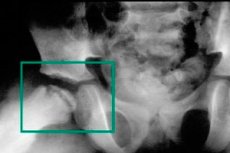Osteochondropathy Perthesa
Last reviewed: 23.04.2024

All iLive content is medically reviewed or fact checked to ensure as much factual accuracy as possible.
We have strict sourcing guidelines and only link to reputable media sites, academic research institutions and, whenever possible, medically peer reviewed studies. Note that the numbers in parentheses ([1], [2], etc.) are clickable links to these studies.
If you feel that any of our content is inaccurate, out-of-date, or otherwise questionable, please select it and press Ctrl + Enter.

The disease in which the blood supply to the femoral head with its further aseptic necrosis is impaired is Perthes' osteochondropathy. It is a fairly common pathology and accounts for about 17% of the total number of aseptic necrosis. It occurs in childhood or adolescence. It is possible, both unilateral and bilateral damage, but the second joint suffers less and recovers faster.
Causes of the osteochondropathy
The degenerative-dystrophic process in the bones refers to polyetiological diseases. There is a theory that this disorder is closely associated with congenital underdevelopment and anomalies of the lumbar spinal cord. The risk factors for Perthes disease include:
- Mechanical injuries: bruises, sprains.
- Inflammation of the hip joint in infectious diseases.
- Hormonal disorders.
- Genetic predisposition and propensity to myelodysplasia.
- Disturbance of mineral metabolism, especially calcium and phosphorus.
 [3],
[3],
Symptoms of the osteochondropathy
Symptoms are manifested by dull pains in walking, which are localized in the region of the hip joint. Discomfort in the knee and over the entire leg is also possible. The patient begins to limp, podvolakivaya affected limb. With further progression, there is swelling of the soft tissues in the area of the joint, restriction of movement, difficulty walking. Vegetative disorders in the distal parts of the sore leg are also possible: cold and pale feet with excessive sweating, low-grade body temperature. In the future, there is a shortening of the limb, the development of arthrosis.
Stages
There are five main stages of the pathological process:
- Violation (termination) of blood supply, the formation of a focus of aseptic necrosis.
- Impression fracture of the femoral head in the area of primary destruction.
- Slow resorption of necrotic tissue and shortening of the femoral neck.
- Growth on the site of necrosis of the connective tissue.
- Fusion fracture - replacement of connective tissue with new bone.
Diagnostics of the osteochondropathy
Treatment of the osteochondropathy
For treatment, complete unloading of the limb, the imposition of skeletal traction and plaster casts are shown. Prescribe medications to improve the blood supply to the joint, stimulate the resorption process of damaged tissues and restore bone. With severe deformity and subluxation of the femur, the rotational transposition of the acetabulum according to Salter or corrective medializing osteotomy of the femur is shown.
Forecast
The prognosis of this form of pathology completely depends on the size and location of necrosis. If the lesion is small, then there are chances for a full recovery. With extensive destruction, the head of the thigh splits into several fragments with the fusion of which acquires an irregular shape. This entails further pathological changes, the formation of contractures, coxarthrosis.

